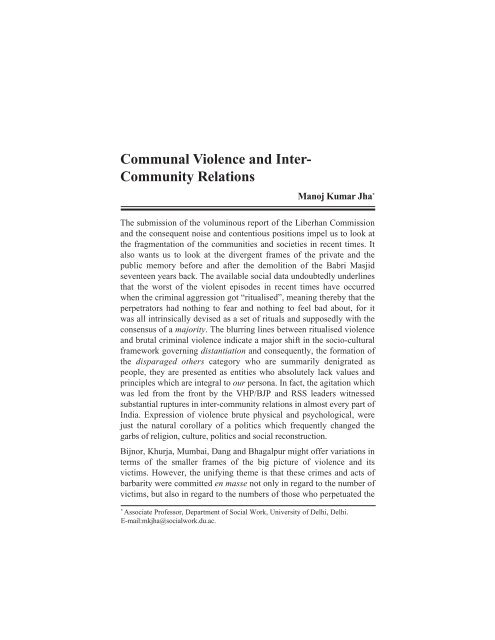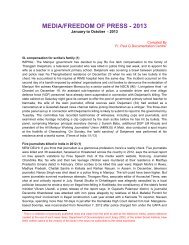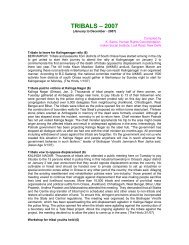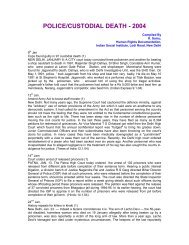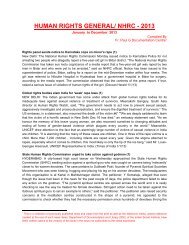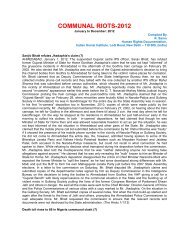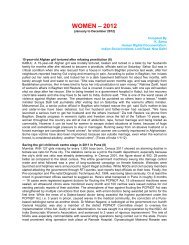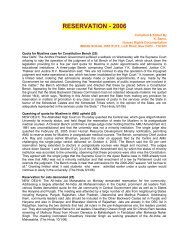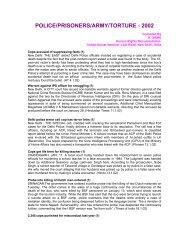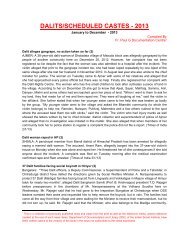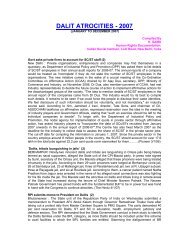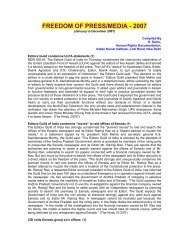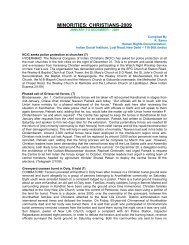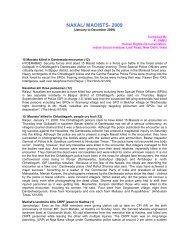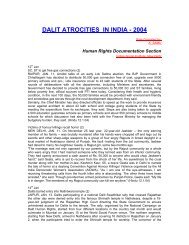Communal Violence and Inter-Community Relations - Indian Social ...
Communal Violence and Inter-Community Relations - Indian Social ...
Communal Violence and Inter-Community Relations - Indian Social ...
You also want an ePaper? Increase the reach of your titles
YUMPU automatically turns print PDFs into web optimized ePapers that Google loves.
COMMUNAL VIOLENCE AND INTER-COMMUNITY RELATIONS 27<br />
<strong>Communal</strong> <strong>Violence</strong> <strong>and</strong> <strong>Inter</strong>-<br />
<strong>Community</strong> <strong>Relations</strong><br />
Manoj Kumar Jha *<br />
The submission of the voluminous report of the Liberhan Commission<br />
<strong>and</strong> the consequent noise <strong>and</strong> contentious positions impel us to look at<br />
the fragmentation of the communities <strong>and</strong> societies in recent times. It<br />
also wants us to look at the divergent frames of the private <strong>and</strong> the<br />
public memory before <strong>and</strong> after the demolition of the Babri Masjid<br />
seventeen years back. The available social data undoubtedly underlines<br />
that the worst of the violent episodes in recent times have occurred<br />
when the criminal aggression got “ritualised”, meaning thereby that the<br />
perpetrators had nothing to fear <strong>and</strong> nothing to feel bad about, for it<br />
was all intrinsically devised as a set of rituals <strong>and</strong> supposedly with the<br />
consensus of a majority. The blurring lines between ritualised violence<br />
<strong>and</strong> brutal criminal violence indicate a major shift in the socio-cultural<br />
framework governing distantiation <strong>and</strong> consequently, the formation of<br />
the disparaged others category who are summarily denigrated as<br />
people, they are presented as entities who absolutely lack values <strong>and</strong><br />
principles which are integral to our persona. In fact, the agitation which<br />
was led from the front by the VHP/BJP <strong>and</strong> RSS leaders witnessed<br />
substantial ruptures in inter-community relations in almost every part of<br />
India. Expression of violence brute physical <strong>and</strong> psychological, were<br />
just the natural corollary of a politics which frequently changed the<br />
garbs of religion, culture, politics <strong>and</strong> social reconstruction.<br />
Bijnor, Khurja, Mumbai, Dang <strong>and</strong> Bhagalpur might offer variations in<br />
terms of the smaller frames of the big picture of violence <strong>and</strong> its<br />
victims. However, the unifying theme is that these crimes <strong>and</strong> acts of<br />
barbarity were committed en masse not only in regard to the number of<br />
victims, but also in regard to the numbers of those who perpetuated the<br />
*<br />
Associate Professor, Department of <strong>Social</strong> Work, University of Delhi, Delhi.<br />
E-mail:mkjha@socialwork.du.ac.
28<br />
SOCIAL ACTION VOL. 60 JANUARY – MARCH 2010<br />
crime. <strong>Inter</strong>estingly, the chief protagonists as well as the perpetrators<br />
committed the crime without ever believing that it was departure from<br />
the normal <strong>and</strong> civilised behaviour. To put it succinctly, they were<br />
living in altered contexts of morality <strong>and</strong> normal situations. This is one<br />
of the main points that Hannah Arendt (2002) emphasises throughout<br />
her report. She does not think that prosecution had proved “beyond a<br />
reasonable doubt” that Eichmann had committed an overt act of murder<br />
“with his own h<strong>and</strong>s”. She strongly objects to what she takes to be the<br />
prosecutor’s melodramatic attempt to demonise Eichmann to portray<br />
him as a “sadistic monster” who was possessed by an “insane hatred<br />
of the Jews”. By relying on such conventional categories, the prosecutor<br />
obscured the character of this “desk criminal” <strong>and</strong> his crimes. Arendt<br />
highlights that Eichmann was neither “perverted nor sadistic”. He was<br />
“terrifyingly normal”. And the perpetration of the most barbaric <strong>and</strong><br />
brutal violence since the mid- 1980s in India was built around the vortex<br />
of terrifyingly normal persons. The victims appeared defenceless <strong>and</strong><br />
numb on account of the fact that actual physical violence followed the<br />
subterranean ideological work by the Sangh Parivar which meticulously<br />
aimed at the othering of certain communities from the private as well<br />
as the public realm in localities. Ironically, studies on mass <strong>and</strong> organised<br />
killings have been marred by a poor underst<strong>and</strong>ing <strong>and</strong> an under-theorising<br />
of othering <strong>and</strong> distantiation. Othering is a broad, imprecisely used<br />
term, encompassing a variety of processes <strong>and</strong> phenomena. This naturally<br />
poses enormous problems for explaining the perpetration of mass killing<br />
because a central task of any such attempt is to evaluate whether <strong>and</strong><br />
how the ideology of othering <strong>and</strong> distantiation produced <strong>and</strong> influenced<br />
its many aspects, the way it did.<br />
Most of the explanations coming in the wake of progression of violent<br />
episodes following the demolition of the Babri Masjid, in reality caricature<br />
the perpetrators i.e., those who chose to participate in the mayhem<br />
since the opening of the lock at the disputed structure. The accounts<br />
treat them as if they had been people lacking the ability to decide a<br />
moral sense, lacking the ability to make decisions <strong>and</strong> take stances.<br />
They do not conceive of the actors as human agents, as people with<br />
wills, but as beings moved solely by external forces or by transhistorical<br />
<strong>and</strong> invariant psychological propensities such as the slavish following of<br />
narrow self-interest.
COMMUNAL VIOLENCE AND INTER-COMMUNITY RELATIONS 29<br />
The conventional explanations available for the progression of the violent<br />
episodes in the decades following the opening of the lock at the disputed<br />
structure at Faizabad also suffer from further conceptual obscurity.<br />
Even before the submission of the Liberhan Commission report, there<br />
was no dearth of detailed narratives of the accounts of the death <strong>and</strong><br />
destruction drawn on diverse episodes of violence from all over India;<br />
they in fact fall much short of underlining the extraordinary nature of<br />
the act i.e. the distantiation followed by mass killing <strong>and</strong> destruction of<br />
the “disparaged others”. Most of the accounts which locate the centrality<br />
of RSS in inciting people to commit such acts of barbarity also depict it<br />
in such a manner in which it appears that killing “others” on the<br />
encouragement of the agency is no different from making them do<br />
other undesirable tasks. In fact one of the most important <strong>and</strong> immediate<br />
tasks for us is to look at the culpability of ordinary people in such<br />
crimes, for so far we have conveniently allowed them to go ahead<br />
freely presuming that they were cajoled to be perpetrators. Drawing<br />
from the writings of Staub (2007), Waller (2007) <strong>and</strong> Goldhagen (1997)<br />
in the context of Nazi Germany, we have reasons including substantial<br />
empirical evidence which suggest that we should not undermine the<br />
actors’ nee perpetrators’ capacity to underst<strong>and</strong>, apprise <strong>and</strong> judge <strong>and</strong><br />
it should also take into account their own personal negotiations with<br />
morality <strong>and</strong> moral framework of connectedness. It needs to be<br />
recognised that we were <strong>and</strong> remain a normal society <strong>and</strong> hence what<br />
made people agree <strong>and</strong> willing to distantiate (at cognitive as well as<br />
spatial level) the “disparaged” others requires a different structure <strong>and</strong><br />
frame of underst<strong>and</strong>ing.<br />
While talking of the nature of evil, Waller (2007) says, “In general<br />
conversation, we easily substitute ‘moral wrongness’ or ‘bad’ for the<br />
term ‘evil’ without any loss of meaning. Even those authors <strong>and</strong> scholars,<br />
who derive <strong>and</strong> make their arguments on the basis of religion <strong>and</strong><br />
philosophy, do not actually define ‘evil’.” Waller (2007) highlights that,<br />
“to specifically define the ‘judgmental’ <strong>and</strong> ‘moralistic’ concept of evil<br />
seems to threaten the academic ideal of ethical <strong>and</strong> value neutrality”.<br />
This is a behavioural definition that focuses on how people act towards<br />
one another; <strong>and</strong> the definition of human evil includes the creation of<br />
conditions that materially or psychologically destroy or diminish people’s<br />
quality of life – their dignity, happiness <strong>and</strong> capacity to fulfil basic<br />
material needs. Such conditions aim to threaten or impact socio-cultural
30<br />
SOCIAL ACTION VOL. 60 JANUARY – MARCH 2010<br />
as well as economic <strong>and</strong> political realms of the “disparaged others”. It<br />
belittles their persona, pushes them further on to the margins <strong>and</strong> without<br />
allowing them any space for speaking out whatever anguish they have.<br />
The Psychology of Perpetrators: Individuals <strong>and</strong> the Cultural<br />
System<br />
To underst<strong>and</strong> the psychology of perpetrators, we must consider their<br />
persona, the forces acting on them, <strong>and</strong> the system they are part of.<br />
The cultural system makes one of the most pervasive impact on the<br />
persona of all known by the differential categories such as perpetrators,<br />
onlookers, byst<strong>and</strong>ers <strong>and</strong> the witnesses through selective over-emphasis<br />
on specific items in the worldview. A worldview, according to Waller<br />
(2007), includes the presuppositions, intentions, meanings, rules, norms,<br />
values, principles, practices <strong>and</strong> activities through which people live<br />
their lives. It is a fundamental orientation that includes the core cultural<br />
ideals of what is good <strong>and</strong> what is moral. Implied in this distantiating<br />
worldview is the obliteration of a common ground between perpetrators<br />
<strong>and</strong> victims <strong>and</strong> between the wounded <strong>and</strong> the witnesses as well as<br />
with regard to the byst<strong>and</strong>ers. Meticulously built aggression towards<br />
the others consequently transcends the boundaries of the moral<br />
framework governing inter-personal <strong>and</strong> inter-community relations as<br />
we have seen in recent times through the orchestrated violence against<br />
Muslims <strong>and</strong> Christians in different parts of India. Needless to reaffirm<br />
that this orchestration of physical violence has followed the call made<br />
by the ideologues that had been emphasising on distantiation of others.<br />
The innermost aspects of distantiation can be seen in the manner in<br />
which we come across newer spaces increasingly appearing witness to<br />
minor altercation being transmogrified into issues of permanent contention<br />
between communities <strong>and</strong> at times amongst the rival factions within the<br />
same community. Politicised religion <strong>and</strong> its rituals perform diverse set<br />
of functions <strong>and</strong> one of them is no matter how much of sin the recruited<br />
ones have committed in the past, they are not to be pushed away from<br />
God, at least in the collective memory of people around. Participation<br />
with vigour <strong>and</strong> dedication in the public theatre of politicised religion in<br />
effect allows them to have recompense come quickly <strong>and</strong> readily for<br />
them. And consequently areas drawn from diverse contexts changed<br />
<strong>and</strong> transformed the way communities looked at inter-community irritants.<br />
Communities had differences <strong>and</strong> altercations always between individuals
COMMUNAL VIOLENCE AND INTER-COMMUNITY RELATIONS 31<br />
but they were never approached with the lens of the political-religious<br />
identity of the communities involved. However, these new spaces in a<br />
short span of time had developed tremendous capacity in signifying an<br />
existing irritant between two individuals (belonging to two different<br />
communities) as ready case in point of intrinsic incompatibilities of<br />
the two religions. We have evidence galore to believe that with the<br />
ostentatious <strong>and</strong> arrogant celebrations of the Ramshila Pujan in diverse<br />
localities, any possibility of rapprochement between the communities<br />
were lost forever. With continuous dress rehearsals, every locality was<br />
an ideal-typical site with adequate number of willing ears <strong>and</strong> disposed<br />
minds to carry out the task expected of them. Volkan’s (1997) Chosen<br />
trauma <strong>and</strong> Chosen glory had become integral ingredients of the<br />
borders <strong>and</strong> boundaries between the communities. “They” i.e., the rioting<br />
crowds did not take much time in establishing an instant chord with the<br />
crowd which had a maypole in the local as well as the national leaders<br />
of the Sangh outfits (Volkan: 1997).<br />
Much before Graham Staines had to happen or a Gujarat 2002 was to<br />
take place, the new India was writing the prologue for more of the<br />
genocidal violence which in all likelihood was seeking greater validation<br />
for distantiation <strong>and</strong> othering in the coming years. The dead ones<br />
have long gone <strong>and</strong> so have the diminutive <strong>and</strong> ritual protests which<br />
were raised against such total violence. But bigger questions remain in<br />
the psyche of the children (who could manage to survive) who are<br />
adults now. And the most fundamental question from them is – what<br />
has been done to retrieve the sites <strong>and</strong> spaces which have been lost to<br />
the ideology <strong>and</strong> ideologues of “othering <strong>and</strong> distantiation”? Like the<br />
Germans during the Nazi regime, people here also shared the life problems<br />
<strong>and</strong> culture that gave them a common inclination, a societal tilt, to<br />
experience certain ways of fulfilling them. The earliest Nazis probably<br />
had characteristics that intensified these needs <strong>and</strong> desires – a wish to<br />
relinquish a burdensome identity, authority orientation, anti-Semitism<br />
<strong>and</strong> these became the means of their satisfaction offered by Hilter,<br />
especially congenial doctors in particular who may have been attracted<br />
to the “biological” aspect of Nazi ideology <strong>and</strong> its scientific racism. The<br />
different categories of leaders such as pseudo-moderates, radicals etc.,<br />
indicated by Justice Liberhan (2009) testifies to multiple layers <strong>and</strong><br />
levels at which the organisations affiliated to the Sangh have been<br />
working to accomplish othering.
32<br />
SOCIAL ACTION VOL. 60 JANUARY – MARCH 2010<br />
Demonisation of Others<br />
The instances of near total violence directed against Christians in Gujarat,<br />
Karnataka <strong>and</strong> Orissa or against Muslims in various places build on the<br />
political <strong>and</strong> moral justification of distantiation. Once the distantiation is<br />
accomplished at the psychic level, expression of violence is merely a<br />
routine <strong>and</strong> a predictable pattern of behaviour directed at others. Before<br />
the desire of the dehumanisation/demonisation gets a favourable climate,<br />
the tendency to dichotomise the world into us <strong>and</strong> them is under way.<br />
As Staub (1959) says, “the ties that bind people to significant in-groups<br />
are much stronger than this: deep affective associations, shared<br />
underst<strong>and</strong>ings, common goals <strong>and</strong> the perception of a shared fate.”<br />
Consequently, enemy groups i.e. those outside of our in-groups are<br />
created <strong>and</strong> categorised by an emerging ideology, usually on the basis<br />
of cultural devaluation. Consequently, dehumanisation appears as a<br />
psychological process whereby the in-group views the other as less<br />
than human <strong>and</strong> thus not deserving moral consideration as well as<br />
political consideration. The accounts of the perpetrators <strong>and</strong> the<br />
byst<strong>and</strong>ers of the riots beginning from the Ramjanma bhoomi agitation<br />
bear testimony to the completed cycle of demonisation <strong>and</strong> this is one<br />
important reason for why it never appeared as morally outrageous to<br />
any significant populace. Protracted conflict not only strains relationships<br />
beyond repair; such conditions often lead to feelings of intense hatred<br />
<strong>and</strong> alienation among the groups. Once moral exclusion of the other is<br />
complete, the killing or the destruction has to negotiate only with the<br />
statutory <strong>and</strong> legal framework, which of course shall operate within the<br />
altered moral framework of the society. Robert Sternberg (2003) moves<br />
further <strong>and</strong> underlines that underneath the demonisation of others as<br />
prerequisite to their decimation lies the subterranean ideology of hate<br />
which is carefully nurtured <strong>and</strong> shaped in order to accomplish ends that<br />
are knowingly planned <strong>and</strong> systematically conceived. In his conceptual<br />
model, Sternberg suggests three components of hate. The first, negation<br />
of intimacy which involves the seeking of distance from a target group.<br />
This component of hate is affective; it is experienced as a negative<br />
emotion. The second component, passion, expresses itself motivationally<br />
as intense anger or fear in response to a threat. The final component,<br />
decision/commitment, is characterised by cognitions of devaluation <strong>and</strong><br />
diminution toward the target group. This is the cognitive component that<br />
is often nurtured by institutions. Dehumanisation starts at the point
COMMUNAL VIOLENCE AND INTER-COMMUNITY RELATIONS 33<br />
when, thanks to the distantiation, the objects at which the bureaucratic<br />
operation is aimed, can <strong>and</strong> are, reduced to a set of quantitative<br />
measures. Dehumanised objects cannot possibly possess a “cause”,<br />
much less a “just” one; they have no “interests” to be considered,<br />
indeed no claim to subjectivity. A strong identification with the same<br />
leads to social death, i.e., the natural death which follows subsequently<br />
is merely a corollary-anticipated <strong>and</strong> desired one!<br />
Ritualised riots <strong>and</strong> disparaged others<br />
The expressions of violence which concerned people at large in the<br />
wake of the Ramjanma bhoomi agitation was crafted around the<br />
perceptions of each others’ identity between the two communities. It<br />
believed that conflict can be caused by accentuating the feelings of<br />
threat for the majority community <strong>and</strong> by further highlighting the Muslims<br />
as disparaged others. Such threat perceptions were drawn from the<br />
mythical version of a tense past, an unresolved or knotty loss in the<br />
public memory. Rituals are associated with <strong>and</strong> are performed according<br />
to a given set of rites <strong>and</strong> happen to be a detailed method laying down<br />
procedures for following up. Rituals also channelise the aspirations into<br />
expressions of collectivity through a progression of performative acts.<br />
Rituals have much more agency <strong>and</strong> dynamism than what constitutes<br />
routine. When rituals are invented <strong>and</strong> propagated they are likely to<br />
generate ritualised minds in ritualised spaces. Participative minds in<br />
such altered <strong>and</strong> designated spaces find arenas where important <strong>and</strong><br />
critical reality is perched. On occasions, activities resemble customary<br />
practices, albeit conducted with more dramatic flair when othering is<br />
accomplished as critical social reality. Groups affirm their identities<br />
through practices that ritualise the routine of everyday life. Annihilations<br />
were always the ideal-typical examples of the violent episodes <strong>and</strong><br />
there was no dearth of them in the episodes of violence we witnessed<br />
since the unlocking of the gate at Faizabad. However, there are other<br />
facets of violence which have not received attention to the same degree<br />
i.e. executing deprivation for disparaged others, prohibiting purchase<br />
from their shops, refusing to supply them basic necessities such as<br />
milk, etc. Besides mental processes: feelings, attitudes <strong>and</strong> values that<br />
individuals <strong>and</strong> communities were made to hold, grounds were prepared<br />
for eruption, legitimisation <strong>and</strong> subsequent glorification of violence. Hate,<br />
fear <strong>and</strong> mistrust as driving feelings were deliberately pushed in the<br />
cognitive structures by the diverse agencies <strong>and</strong> instruments of Sangh
34<br />
SOCIAL ACTION VOL. 60 JANUARY – MARCH 2010<br />
Parivar, which allowed people to classify Muslims as barbaric, uncivilised<br />
<strong>and</strong> disparaged others. If an entire community lacked human values as<br />
we have within us, killing <strong>and</strong> annihilation of disparaged others, does<br />
not prick community conscience at any significant level. In intense<br />
conflict situation communities’ sense of “who they are” mixes up with<br />
“why they are so” <strong>and</strong> the plight, the vulnerability, the miseries seen<br />
around us are attributed to the disparaged others, making the cycle of<br />
dehumanisation complete in all aspects.<br />
We can also look at the way the leaders of the Hindutava movement<br />
tried developing their social, cultural <strong>and</strong> political aims into a whole.<br />
They, in fact, learnt a beautiful lesson from Frame theory which is<br />
pivotal in the making <strong>and</strong> maturation of any movement. Frames, according<br />
to Benford <strong>and</strong> Snow (1992) are “slices of observed, experienced, <strong>and</strong>/<br />
or recorded ‘reality’ [which] are assembled, collated <strong>and</strong><br />
packaged....such that a new angle of vision, vantage point, <strong>and</strong>/or<br />
interpretation is provided”. By carefully altering the way the Hindutva<br />
movement constructed <strong>and</strong> presented itself, it changed probably forever<br />
the discourse between us <strong>and</strong> them, or the other. It altered all possible<br />
reasons <strong>and</strong> mechanisms by which public conscience could have come<br />
to critically engage with the multilayered processes of othering. In the<br />
carefully designed frame where the locus of the problem was prediagnosed<br />
by the organisations through all possible manipulation,<br />
attribution (of the blame) came quite naturally to the confirmed converts<br />
as also to the potential ones who were fence sitters for the Hindutva<br />
movement. The carefully orchestrated operational part of frame<br />
resonance predefined the degree to which individuals could identify<br />
with the stated positions of the newly developed frames of Hindutva. It<br />
naturally provided immense opportunities by which the movement wrote<br />
the script for a “new India” <strong>and</strong> consequently achieved resonance with<br />
a wide <strong>and</strong> diverse audience from diverse cultural <strong>and</strong> regional zones.<br />
Resonance also proved to be the manifestation of what is known as<br />
consensus mobilisation, whereby movements “activate individuals who<br />
already agree with their views <strong>and</strong> aims” (Snow <strong>and</strong> Benford, 1992).<br />
Identity Construction, Memories <strong>and</strong> <strong>Inter</strong>-<strong>Community</strong> <strong>Relations</strong><br />
While mapping the contours of the community it is imperative to locate<br />
<strong>and</strong> delve into the issues of memory <strong>and</strong> history besides identity at the<br />
local level. It is generally understood that for any discernible <strong>and</strong> disturbing
COMMUNAL VIOLENCE AND INTER-COMMUNITY RELATIONS 35<br />
rupture in community relations, the adversaries must have a sense of<br />
collective identity about themselves <strong>and</strong> about others against whom<br />
they are supposedly juxtaposed. And in the process of conflict each<br />
side believes that the fight is between us <strong>and</strong> them. Developing a sense<br />
of self is an essential part of every individual’s evolutionary pattern<br />
within the larger community identity. Each person’s self-conception is a<br />
distinctive combination of several identifications based on gender, class,<br />
sect, religion etc. Although identity of the self may apparently coincide<br />
with a particular human being, identities per se are actually much wider<br />
than that. In their best perceived sense, identities are collective <strong>and</strong><br />
they stretch beyond borders created by the states <strong>and</strong> the governments.<br />
Locating identity in our times Bauman (2004) writes: “In our world of<br />
rampant ‘individualisation’, identities are mixed blessings. They vacillate<br />
between a dream <strong>and</strong> a nightmare, <strong>and</strong> there is no telling when one will<br />
turn into the other. At most times the two liquid modern modalities of<br />
identity cohabit, even when located at different levels of consciousness.<br />
In a liquid modern setting of life, identities are perhaps the most common,<br />
most acute, most deeply felt <strong>and</strong> troublesome incarnations of<br />
ambivalence.<br />
Moving a little further, we also realise that hegemonic superimpositions<br />
too create <strong>and</strong> construct identities for the individuals <strong>and</strong> the groups.<br />
And on account of the pervasive impact of these constructed identities,<br />
people feel (or are made to feel) injured when other persons sharing<br />
their identity are injured or killed. It should be stressed that huge physical<br />
distance is no check that the images seen <strong>and</strong> perceived shall not cross<br />
administrative borders <strong>and</strong> boundaries. Identities are constructed on<br />
the basis of various traits <strong>and</strong> experiences <strong>and</strong> there are large numbers<br />
of players engaged in the vocation of identity construction. Several of<br />
those characteristics, which are presented as sets of identity markers<br />
are in reality open to different readings, interpretations <strong>and</strong> explanations.<br />
Identities are portrayal of the self as also attributes projected on to<br />
others. They also indicate not only who we are but what others think<br />
of who we are. Bauman (2004) depicts the distinction between choices<br />
<strong>and</strong> free will of some on the one h<strong>and</strong> <strong>and</strong> of incapacitated on the other<br />
h<strong>and</strong>, others as far as identities are concerned. “Let me note that<br />
identification is also a powerful factor in stratification; one of its most<br />
divisive <strong>and</strong> sharply differentiating dimensions. At one pole of the
36<br />
SOCIAL ACTION VOL. 60 JANUARY – MARCH 2010<br />
emergent global hierarchy are those who can compose <strong>and</strong> decompose<br />
their identities more or less at will, drawing from the uncommonly large,<br />
planet-wide pool of offers. At the other pole are crowded those whose<br />
access to identity choice has been barred, people who are given no say<br />
in deciding their preferences <strong>and</strong> who in the end are burdened with<br />
identities enforced <strong>and</strong> imposed by others; identities which they<br />
themselves resent but are not allowed to shed <strong>and</strong> cannot manage to<br />
get rid of. Stereotyping, humiliating, dehumanising, stigmatising<br />
identities...” Such constructed identities, if remain uncontested, can persist<br />
for generations creating borders <strong>and</strong> boundaries between us <strong>and</strong><br />
them. We do need to admit that arriving at the foundation of the intercommunity<br />
relations is a worthwhile aim to pursue irrespective of the<br />
hazards <strong>and</strong> risks it entails <strong>and</strong> if the process of seeking information<br />
touches the core of the people’s heart, many corridors of the past as<br />
they see are open to us. On the other h<strong>and</strong>, memory is an interdependent<br />
process of remembering <strong>and</strong> forgetting. Memory is also a label for a<br />
diverse set of cognitive capacities by which humans retain information<br />
<strong>and</strong> reconstruct past experiences, usually for present purposes. However,<br />
when the external stakeholders are at work in helping people remember<br />
(read manufacturing), remembering is often immersed with emotion—<br />
a heightened passion, an irrational one as we have seen in our times.<br />
As such with manufactured memories, the casualty list includes<br />
rationality, reasoning <strong>and</strong> logical interpretation of events. Memory goes<br />
wrong in disastrous ways <strong>and</strong> the contemporary history bears witness<br />
to the same. Memory also is a storehouse of different constituents<br />
besides possessing a ready reference for an actual or anticipated event.<br />
The past does not correspond to the real in any direct, unmediated way<br />
since what we remember are memories–screens always already<br />
impressed by the fantasies or distortions of a series of successive<br />
remembering. Hence memories, like dreams, are highly condensed<br />
symbols of hidden preoccupations (Halbwachs, 1992). We must also<br />
realise that imagining the past differently from what it was can change<br />
the way one remembers it. What is it about imagining a counterfactual<br />
event that causes people to later become more confident that it really<br />
happened? A growing literature shows that imagination can change/<br />
alter <strong>and</strong> even destroy autobiographies <strong>and</strong> that applies to the persona<br />
of all large groups including a nation or community.
COMMUNAL VIOLENCE AND INTER-COMMUNITY RELATIONS 37<br />
Memory serves as both a phenomenological position of identity <strong>and</strong> a<br />
carrier for overt identity construction. As memory emerges into<br />
consciousness, eternalized <strong>and</strong> increasingly objectified, it depends on<br />
cultural vehicles for its expression. In building connections between the<br />
past <strong>and</strong> the present, between who we are <strong>and</strong> what others perceive us<br />
to be, narratives or stories dug from the past have a very important<br />
contribution.<br />
One important aspect of memory indicates what people remember.<br />
Halbwachs (1980) argued that what we choose to remember derives<br />
from the social arena which people always inhabit when they remember.<br />
He therefore introduced the term collective memory (memoires<br />
collective). Halbwachs (1992) stressed how strongly social processes<br />
influence not only people’s personal memories of their own lifetimes,<br />
but also a community’s shared memories of the past. Such collective<br />
memories are crucial for the identity of groups such as families, believers<br />
<strong>and</strong> followers of a religion, or social classes (Halbwachs 1992). James<br />
Young should join in here (1992) to remind that we should rather speak<br />
of collected memory rather than collective memory.<br />
The nature of the networks within a particular place or grouping is of<br />
fundamental importance when making judgements about community as<br />
a space <strong>and</strong> community as feeling of solidarity; <strong>and</strong> the extent to which<br />
people can find shared spaces within them. Ability to <strong>and</strong> availability<br />
of opportunities to connect to others <strong>and</strong> interact with them widens the<br />
possibility of a broad spectrum of community. However, shared histories<br />
in shared spaces have been one of the most important casualties in<br />
recent times in the process of othering whereby an adversarial identity<br />
is superimposed on them without their approval <strong>and</strong> consent.<br />
Manufactured superiority <strong>and</strong> imposed inferiority on to others further<br />
complicates community life in locales where familiarity <strong>and</strong> unbridgeable<br />
social distance can happily go with each other.<br />
It shall not be an exaggeration to underline that people <strong>and</strong> communities<br />
do not always form opinion about the self (us) <strong>and</strong> others on the basis<br />
of their own personal encounters <strong>and</strong> experiences but, more often the<br />
guide for interaction comes from above, from distant quarters with or<br />
without the consent of the receivers. Such freely rented experiences<br />
have added to the make-up <strong>and</strong> hardened postures of beliefs <strong>and</strong> a<br />
subsequent take on “self” <strong>and</strong> “others”. The images of hurt <strong>and</strong> distress
38<br />
SOCIAL ACTION VOL. 60 JANUARY – MARCH 2010<br />
caused to the victims of inter-community violence have not been able to<br />
pervade the extant notions of morality <strong>and</strong> justness <strong>and</strong> ironically life<br />
moves on but leaves a few posers <strong>and</strong> one of them is that the violence<br />
aimed at the disparaged others cannot simply be perceived as malicious<br />
design of an agency guiding the events through a remote control. They<br />
made us kill you is a very poor defence <strong>and</strong> hence cannot st<strong>and</strong> critical<br />
prosecution.<br />
REFERENCES<br />
Arendt, Hannah. 2002 “Eichmann in Jerusalem: A Report on the Banality<br />
of Evil” in Alex<strong>and</strong>er.<br />
Laban Hinton (ed.) Genocide: An Anthropological Reader, Oxford:<br />
Blackwell Publishing.<br />
Bauman, Z. 2004. Identity. Cambridge: Polity Press.<br />
Goldhagen Daniel Jonah. 1997, New York, Vintage Books<br />
Halbwachs, M. 1980. The Collective Memory, London, Harper <strong>and</strong><br />
Row<br />
Halbwachs, M. 1992 On Collective Memory. Chicago: University of<br />
Chicago Press<br />
Liberhan M.S. 2009. Report of the Ayodhya Commission of Inquiry.<br />
Delhi: Government of India.<br />
Robert J. Sternberg. 2003. “A Duplex Theory of Hate: Development<br />
<strong>and</strong> Applications to Terrorism, Massacres, <strong>and</strong> Genocide” Review<br />
of General Psychology.<br />
Snow, David A. <strong>and</strong> Robert D. Benford .1992. “Master Frames <strong>and</strong><br />
Cycles of Protest” in Aldon D. Morris <strong>and</strong> Carol McClurgMueller<br />
(eds). Frontiers in <strong>Social</strong> Movement Theory. New Haven: Yale<br />
University Press.<br />
Staub, Ervin. 2007. The Roots of Evil. Cambridge: Cambridge University<br />
Press.<br />
Waller, James. 2007. Becoming Evil. Oxford: Oxford University Press.<br />
Young, J. E. 1992. “The Counter-Monument: Memory Against Itself in<br />
Germany Today”, Critical Inquiry, 18: 267–96.


